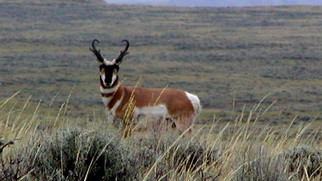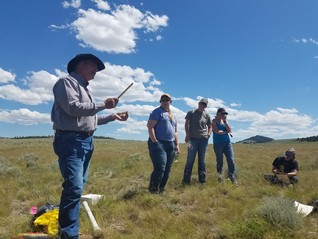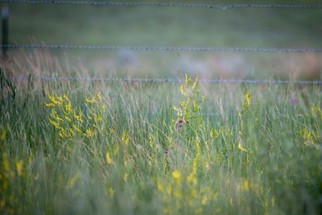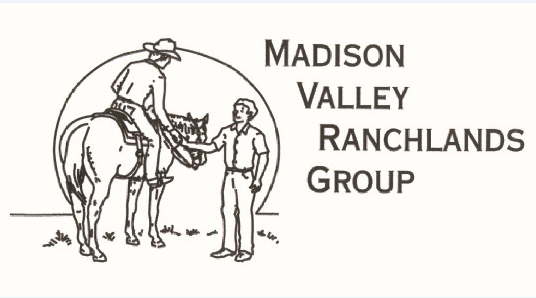
Welcome to the Rangeland Resources Program newsletter!
Featuring key information about our program, notifications about upcoming events, and news blasts, this newsletter will keep you up to speed with everything Montana rangeland. If you have any suggestions for future newsletters, please contact Stacey Barta at SBarta@mt.gov.
Hunting season is upon us. I am so grateful for the stewards of private lands that are kind and gracious enough to allow hunters to hunt their operations. It's a true prividlege for those who hunt, and at times a real pain in the behind for the rancher. So thank you for allowing hunting!
|

Protecting U.S. Rangeland from
Grasshoppers and Mormon Crickets
Gary Adams-State Plant Health Director, Montana-USDA, APHIS, PPQ
Photo Reba Ahlgren- Winnett
Rangeland in the Western United States is a valuable agricultural resource for livestock production and provides an important habitat for wildlife. Grasshoppers and Mormon crickets (referred to collectively as grasshoppers) are natural components of this ecosystem. However, their populations can reach outbreak levels and cause serious economic and ecological losses to rangeland forage, especially during periods of drought.
When a grasshopper outbreak threatens rangeland forage, Federal land management agencies, Native American tribes, State agriculture departments, county and local governments, private groups, and/ or individuals can request assistance from the U.S. Department of Agriculture’s (USDA) Animal and Plant Health Inspection Service (APHIS) to suppress rangeland grasshopper populations.
Grasshoppers and Mormon Crickets
Grasshoppers and Mormon crickets are closely related insects that belong to the order Orthoptera. Nearly 400 grasshopper species inhabit the Western United States, but only a small percentage are considered pest species. Anywhere from one to many grasshopper species can be found in a particular rangeland ecosystem, and economic damage usually occurs when pest grasshopper species increase in number.
Grasshoppers are typically ground-dwelling insects with powerful hind legs that enable them to escape from threats by leaping vigorously. They are sometimes referred to as short-horned grasshoppers to distinguish them from katydids (bush crickets), which have much longer antennae. Mormon crickets (Anabrus simplex) are flightless, shield-backed katydids. Although they do not fly, Mormon crickets are highly mobile and capable of migrating great distances. They move in wide bands by walking or jumping and may devour much of the forage in their path.
Both insects damage grasses and other vegetation by consuming plant stems and leaves. Their feeding causes direct damage to plants’ growth and seed production. This reduces valuable livestock forage and can lead to other effects, including soil erosion and degradation, disruption of rangeland nutrient cycles,
interference with rangeland water filtration, and potentially irreversible changes in the rangeland ecosystem. In addition, some populations that develop on rangelands can invade adjacent cropland where the value of crop plants is much higher than that of rangeland grasses.
APHIS’ Grasshopper Program
APHIS surveys rangeland grasshopper populations in 17 Western States: Arizona, California, Colorado, Idaho, Kansas, Montana, Nebraska, Nevada, New Mexico, North Dakota, Oklahoma, Oregon, South Dakota, Texas, Utah, Washington, and Wyoming. In addition, APHIS provides technical assistance on grasshopper management to landowners and managers, delivers public outreach and education programs, and may work with Federal and State agencies, tribes, and landowners to suppress grasshopper populations when direct intervention is necessary.
APHIS treats grasshoppers only upon request and after determining that treatment is warranted. When a Federal land management agency, Native American tribe, State agriculture department, county or local government, private group, or individual with jurisdiction over the land makes a written request for grasshopper treatment, APHIS visits the site and assesses various factors to determine whether action is necessary. These factors include, but are not limited to, grasshopper densities per yard, the pest species and its biological stage, treatment timing and options, and other ecological considerations. County, State, and Federal officials, tribes, and/or rancher groups may also initiate cooperative local programs and request APHIS assistance when surveys show the potential for large grasshopper populations.
Cost Sharing for Grasshopper Suppression Treatments
Federal agencies own or manage approximately 43 percent of U.S. rangeland. The U.S. Department of the Interior’s Bureau of Land Management, the Bureau of Indian Affairs or individual tribes, and USDA’s Forest Service are among the principal managers of the rangeland. Federal rangeland eligible for cooperative grasshopper suppression treatments from APHIS includes: areas with widespread outbreaks; areas with developing or incipient populations of grasshoppers, that, if treated, would prevent a wider spread of outbreaks; and Federal or Trust land borders that, if treated, would prevent the movement of economically threatening populations of grasshoppers to adjacent private agricultural lands.
APHIS shares the costs of providing grasshopper suppression treatments on Federal, State, and private rangeland as directed by the Plant Protection Act. On Federal and tribal Trust lands, APHIS pays
100 percent of the treatment cost. On State lands, APHIS provides 50 percent of the funds for treatment and control. On private Montana rangelands, APHIS provides 33 percent of the funding and private landowner responsible for paying the remainder of the treatment cost. This cost share is only available if APHIS conducts the suppression treatments.
APHIS does not have the authority to conduct grasshopper suppression programs on private crop lands. However, APHIS conducts rangeland treatments in areas where federally administered rangeland is immediately adjacent to crops. This not only protects the rangeland forage, but also prevents grasshoppers from moving into the adjacent crops. In these situations, APHIS does not treat the crop land, only the adjacent rangeland; the crop owner is responsible for any crop land treatments that may be needed. In addition, if small amounts of croplands (typically less than 10 percent of the treatment area) are interspersed in a rangeland treatment block, APHIS could treat the entire block in order to maintain the continuity of the spray program. The insecticide, however, must be labeled for use on that crop. In such cases, the private landowner would pay 100 percent of the cost for treatments conducted on their crop land.
Additional Information
For additional information on APHIS’ grasshopper program, please visit the APHIS Web site at https://www.aphis.usda.gov/aphis/ourfocus/planthealth/plant-pest-and-disease-programs/pests-and-diseases/grasshopper-mormon-cricket/ct_grasshopper_mormon_cricket
or contact your State Plant Health Director (SPHD) at Gary.D.Adams@usda.gov or 406 657 6282. You can also contact your local MSU Extension Agent for more information.
|

Livestock Grazing on Public Lands: Things Every Rancher Needs to Know
If you were not able to tune in to Dr. Jeff Mosley's recent webinar, no worries you can listen anytime!
Dan Scott Ranch Management Program Lecture Series.
Dr. Mosley did a fantastic job explaining the history of public lands grazing, right up to present day process and challenges. I encourage everyone, even if you are not a public land grazer, to listen to this webinar!
|

Feral Hog Shot in East Idaho
Idaho State Journal | Oct. 15, 2020
The Jefferson County Sheriff’s Office notified the Idaho Department of Fish and Game. Jefferson County Senior Animal Control Officer Evan Smith and Idaho Fish and Game conservation officer Devin Skidmore estimated the hog weighed about 150 pounds and was a few years old. It looked like she'd had a litter at some point. Read more.(photo is Google stock image)
|

Beginning rancher revitalizes retired CRP to grow her herd and wildlife habitat
By Laura C. Nelson, Ranchers Stewardship Alliance
The old homestead still stands sentinel on the hill.
Weathered, worn and abandoned long ago, Heather Martin has often looked at the relic and wondered just how the brother-sister duo who claimed this parcel more than a century ago thought they could make a living off such a small sliver of sandy soil.
“There’s no well, no running water, and when this reservoir dries up, there’s nothing,” the Phillips County rancher says, nodding to the still pool nestled in the natural basin. “Maybe they got more rain back then, maybe it held more snow – I just don’t know. It had to have been a tough living.”
As decades wore on, making a living on that land didn’t get any easier. It was plowed, then entered into the Conservation Reserve Program (CRP) in the 1990s, indicating it was considered marginal cropland, at best. Planted to crested wheatgrass, a non-native but prolific species, it was left to weather the elements like the homestead decades before. The crested wheatgrass took root and covered the bare ground as intended, but wildlife search for tender, native grasses to graze. Dead growth became a barrier to new life.
Still, like many before her, Heather Martin saw opportunity.
“I was trying to grow; we were running out of ground. I was just trying to make it work, this ranching deal,” she says. “It’s all I’ve ever wanted to do. I’ve known that since I was eight years old.” Read the rest of Herd & Hope
|

Madison Valley Ranchlands Group
Linda Owens- MVRG Program Director
Madison Valley Ranchlands Group (MVRG) was originally formed in 1996 by seven local ranching families to encourage sustainable and productive agricultural practices in the Madison Valley area of southwest Montana. We work to accomplish this by advocating forward thinking ideas that enhance the economic vitality and viability of family ranches. We back productive agriculture, private property rights, open space, healthy grasslands, wildlife habitat and protecting the watersheds that make life here possible. We work cooperatively with groups, agencies and individuals who share our goals and our commitment to the land and caretaking the species that live here, wild and domestic. We are advocates of the 80/20 rule, working with unlikely partners in the 80% we agree on. We are not afraid to lean into places of disagreement to find solutions to problems. Nor will every solution be successful in the long run; but: “To not try is to fail.”
In 2020 our collaborative effort has been focused on helping develop and implement programs and strategies for large predator management and education plans for the general public regarding grizzly bears and wolves. Southwest Montana’s expanding grizzly population has brought the struggle to make wise, even tempered decisions that will have long term impacts on wildlife, ranching and farming, publicly held lands, and the safety of the people living, working, and recreating here, to the forefront.
MVRG operates a livestock carcass pickup program that services the east side of Madison County and built the first DEQ licensed, livestock carcass compost facility in Madison County with the help of seven partner organizations. With funding from the Livestock Loss Board, MVRG developed and sent out 500 Rancher’s Guide To Predator Attacks on Livestock saddle bag kits to ranchers and riders in Montana this year. MVRG partnered to build 50 first aid trauma packs this fall for range riders and other high risk individuals.
Brucellosis, elk management, the Designated Surveillance Area (DSA), range riders, CWD, conifer expansion, and community stewardship are a few more areas MVRG focuses on.
Remember; “ You are either at the table or on the menu.”
|
Wyoming Public Radio | By Catherine Wheeler
Published October 21, 2020 at 4:00 PM MDT

Catherine Wheeler/Wyoming Public Radio
Eighteen plots are laid out on the hillside on Brian Mealor’s property in Sheridan County, Wyo. Mealor is studying how differing amounts of herbicide sprayed at different times of year can be used to manage invasive species.
On the side of a rocky hill in Sheridan County in northern Wyoming, Brain Mealor is showing off all of his weeds.
“Here, let me grab a cheatgrass so you can see it, too,” he said, plucking a wispy sprig from among the grasses. “They all kind of look the same this time of year.”
Mealor is the director of the University of Wyoming’s Research and Extension Center in Sheridan. He’s performing experiments on how to manage and kill invasive annual grasses, like cheatgrass, ventenata and medusa head, with herbicides. For complete story and podcast click here.
Northwest Farm Credit Services Virtual Conferences
Virtual Ag Outlook Conference
Hear insights from experts on current events and trends that will affect the near- and long-term outlook for the agriculture industry and your operation at our Virtual Ag Outlook Conference coming up in November. State-specific sessions feature presentations and business planning tips from customer favorites, economist Dr. Dave Kohl and atmospheric scientist Eric Snodgrass. Then, join us for two additional Ag Outlook sessions for a timely look at the political climate and economic landscape. Register Today [click.go.northwestfcs.com]
|
|
Crown Managers Partnership
|
Pour yourself a cup of coffee, tea, or lemon water, and join the Crown Managers Partnership for the second webinar in our new monthly series: Conservation, the Crown, & Coffee! Have you wondered…
What new and exciting native trout restoration projects and partnerships are happening in the Crown?
How have Aquatic Invasive Species efforts evolved and adapted in the Crown over time?
What future water related efforts are in the works?
This month’s FREE webinar, Watershed Integrity in the Crown, will help answer these questions and more! Be sure to register below to join us on NOVEMBER 13th, 10am-11am (Mountain Time)!
REGISTER NOW! [f69e.engage.squarespace-mail.com]
|
Women in Ranching Beyond Fencelines, Nov. 13th-15th
2020 Virtual Wild Pig Conference
Livestock Grazing on Public Lands-Things Every Rancher Should Know- Dan Scott Ranch Management October Natural Resource Policy Seminar Series
https://tippetrise.org/podcasts/a-love-of-the-land [tippetrise.org]
https://tippetrise.org/podcasts/a-healthy-forest [tippetrise.org]
How palates link soil, plants, herbivores and humans by Dr. Fred Provenza
Western Governors’ Association hosted a webinar to launch a new Toolkit for Invasive Annual Grass Management in the West [westgov.org]
“Out West” podcast, The Buzz About Murder Hornets – Separating Fact from Fiction [westgov.org]
Land Sustainability and Stewardship
Watershed Stories - Montana Watershed Coordination Council recently produced watershed stories, check them out.
Rangeland Podcasts- The Art of Range podcast provides education through conversation with some of the brightest minds in rangeland management.
This video covers field characteristics important for identifying four non-native annual grasses invasive in Montana: cheatgrass (Bromus tectorum), Japanese brome (Bromus japonicus), ventenata (Ventenata dubia), and medusahead (Taeniatherum caput-medusae).

Coordinator Corner- The forgotten space in between.
|
Well October was full of surprises, record high temperatures, extended fire season that ended with record low temps and snowfall amounts. I am a documentary junkie, my family pokes fun at my obsession. I recently watched all of the Great Canadian Rivers on Amazon Prime. Super cool, and they have one episode on the Milk River-Episode 21. If you are bored and tired of mainstream TV, try watching this series! Rangelands and Grasslands are the giant ecosystem in between mountains and the rivers, they are often the forgotten space. The episode on the Milk showcases the integral role prairies have on the watershed. The Milk as you know is transboundary river. The St. Mary's diversion drop 5 suffered a catastrophic breach this spring. Many partners jumped into action and water is now flowing as I type.
Happy Trails. -Stacey
NRCS Events. Calendar of conservation workshops and training
Natural Resource & Policy Series- Dan Scott Ranch Management Program
Several Annual meetings are going virtual the next few months. Be sure and check out websites.
Stacey Barta, Program Coordinator
220 W. Lamme, Suite 1A
Bozeman, MT 59715
(406) 594-8481
SBarta@mt.gov
Rangeland Resources Committee:
John Hollenback, Chairman
Steve Hedstrom, Vice Chairman
Diane Ahlgren
Noel Keogh
Connie Iversen
Sigurd Jensen
|